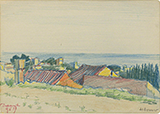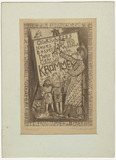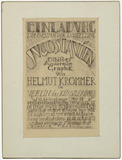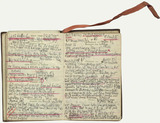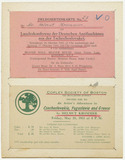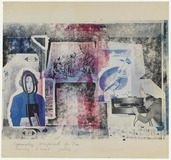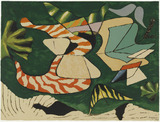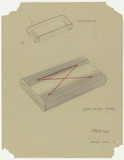Helmut Krommer: Dubrovnik, Drawing (9 June 1939)
From Prague to England via the BalkansIn March 1939 German military forces succeeded in annexing Czechoslovakia. The many artists who, in the years previously, had fled the Nazi regime, could no longer go about their lives safely in the newly annexed nation.
Helmut Krommer: Glücklicheres Neues Jahr 1933, etching (1932)
“In winter and in summer. Etchings by Krommer”.
Helmut Krommer: Invitation to his Yugoslavia exhibition in Berlin, etching (April 1933)
Das Jahr 1933 brachte dem Maler und Grafiker Helmut Krommer anfangs beruflich noch das, was er seinen Freunden auf einer Neujahrskarte gewünscht hatte: Glück und Erfolg. Krommer zeigte im April 1933 in Berlin Ölbilder, Aquarelle und Grafiken mit jugoslawischen Motiven.
Helmut Krommer’s calendarentry noting the end of the Second World War (7 May 1945)
On 7 May 1945, according to the artist’s calendar entries, Helmut Krommer‘s wife, Valerie, purchased a brown suitcase from a certain “Mr. Tinsey”.
Helmut Krommer’s delegate card for an anti-fascist conference in London (16/17 October 1943)
Political Statements in ExileThe painter and graphic artist Helmut Krommer was a committed social democrat. His support for the Social Democratic Party of Germany (Sozialdemokratische Partei Deutschlands, or SPD) quickly brought him to the attention of the Nazis.
Herbert Bayer: Collage as Christmas Greeting Card (1942)
This spoiled print, featuring a design by Herbert Bayer, is a fragment of a brochure Bayer produced for the General Electric Company in 1942. This information booklet was designed to inform readers about the functions, the impact and the future applications of electronic technology, using a combination of graphic and photographic representations.
Herbert Bayer: Fluttering Wings (1945)
Herbert Bayer, who established an international reputation as a typographer, commercial artist and exhibition designer during the 1920s and 30s, ultimately considered himself a painter.
Herbert Bayer: Gift Package Design (1940)
Arriving in New York in 1938, Herbert Bayer soon found work as an advertising graphic designer for the Container Corporation of America (CCA) - a packaging company run by the business executive Walter Paepcke - an American of German descent.
Herbert Fiedler: [Polder near Eemnes] (1937)
From an artistic viewpoint, the years of exile in Laren were fertile ones for the painter Herbert Fiedler, yet unlike 1926 to 1934, they were years without any travel, exchange, recognition or financial success. The first works of this period breathe liberation, openness, artistic perspectives.
Herbert Fiedler: Air Raid, Diary entry 1944
The painter, Herbert Fiedler, drafted into the German Armed Forces, painted the bombing of the Royal Air Force as a bridge guard in Rotterdam on 29 November 1944, which began at around noon “[g] egen 1200” [at about 12.00].
